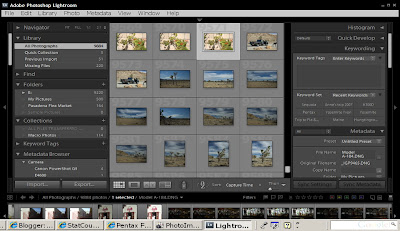Pentax has moved closer to the Professional caliber DSLR cameras with the K20D, although I see no reason it is not in the Professional class to begin with. It is a better camera than that 8 mp expensive Professional DSLR camera that sold around $8,000.00 a few years ago… you know the one! It is just as good as or better than some Professional cameras available today at a much higher price. Anyway, the purpose of this post is not about comparing the criteria of Professional camera versus Advanced Amateur cameras. We’ll keep that for another post.
We spent a serious amount of money for our Pentax DSLR, whether it’s the K10D, K20D, K200D, or one of the K100D series. The camera body is just the beginning. If you were to sit down and add all of the purchases you made on photographic related items since getting your camera body, you may be in for a surprise. Count the lenses, cases, filters, magazines, books, cleaning stuff, etc, I bet you have spent a lot more than what you spent for the camera body.

Then, the LBA saying (Lens Buying Addiction) started by Lance Blackburn of Australia, really made me think of how many lenses I purchased, sold, traded, over the last few years. I have to keep that number secret.

You all know that the lenses are actually the most important part of your photographic system. Buy good glass, and you’ll have them forever, especially with the backward compatibility of Pentax cameras. It doesn’t pay to buy cheap lenses as the quality of your pictures will suffer. I prefer buying lenses made by the camera manufacturer. They know their cameras better than anyone else and design their lenses to suit. I personally would rather have one excellent lens than half a dozen cheap lenses. The problem, at least for me, is the cost of purchasing the lenses. I don’t have that proverbial money tree in my backyard.
Photography is my passion, but not necessarily my wife’s passion. She doesn’t always agree with my LBA. I learned through the years, that good marketing entails creating win/win situations, or at least the perception of a win/win situation. If I get lenses, my spouse should get something too. Actual monetary value does not necessarily have much to do with it. You know…it’s the thought that counts.
Don’t think that buying lenses first and taking her out for dinner after the fact will do. Of course, we should all spend money within our budget, but everything runs much smoother when both of us get something. Knowing my wife like I do gives me the insight of treating her good first, before I buy my lenses. How could she get upset after I spend money on her? She loves shoes, purses, and sunglasses. I can buy many of those for the price of one good lens. So we buy shoes, purses, sunglasses and other “stuff” for her often and when it’s my turn to buy a new lens, I get what I want without any disagreements.
There are many women in photography now and I suppose that the opposite applies as well. Let him buy what he likes…then buy your lenses.
You know, in the end, it’s probably me that gets the short end of the stick. My wife is likely aware of my scheme and really lets me think that I’m in a win/win situation. How can I disagree anytime she buys clothing, shoes, etc? I want my lenses and I even tell her how good she looks in her new “stuff”.
Thanks for reading,
Yvon Bourque

 I haven’t written anything for the past five days or so. My daughter and my granddaughter were visiting and we spent some times at Disneyland, California. I will post about that later on this week.
I haven’t written anything for the past five days or so. My daughter and my granddaughter were visiting and we spent some times at Disneyland, California. I will post about that later on this week.


 All of the flowers above were less than 1/4" across.
All of the flowers above were less than 1/4" across.










 Most of us have pets. It appears to be universal. Dogs especially have been human’s companions for centuries, although cat and bird drawings were found on walls of ancient civilizations.
Most of us have pets. It appears to be universal. Dogs especially have been human’s companions for centuries, although cat and bird drawings were found on walls of ancient civilizations.



 The pictures will have to be rotated 180 degrees but all Pentax DSLRs can do that in-camera. It even gives you a sense of the world viewed from the dog’s point-of-view. No wonder small dogs bark and are sometimes scared of people. We look like giants to them.
The pictures will have to be rotated 180 degrees but all Pentax DSLRs can do that in-camera. It even gives you a sense of the world viewed from the dog’s point-of-view. No wonder small dogs bark and are sometimes scared of people. We look like giants to them.